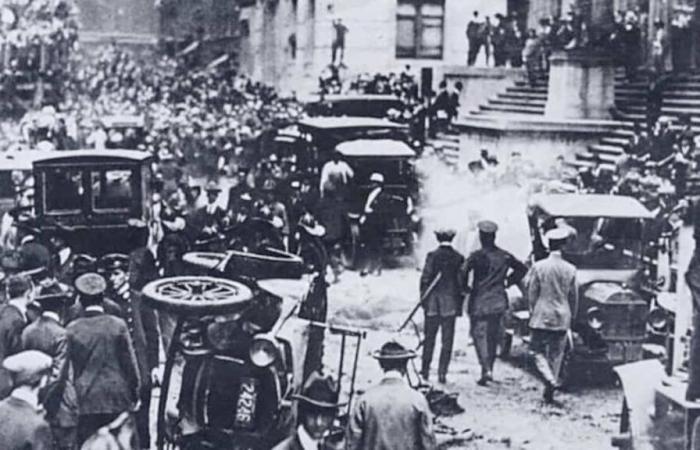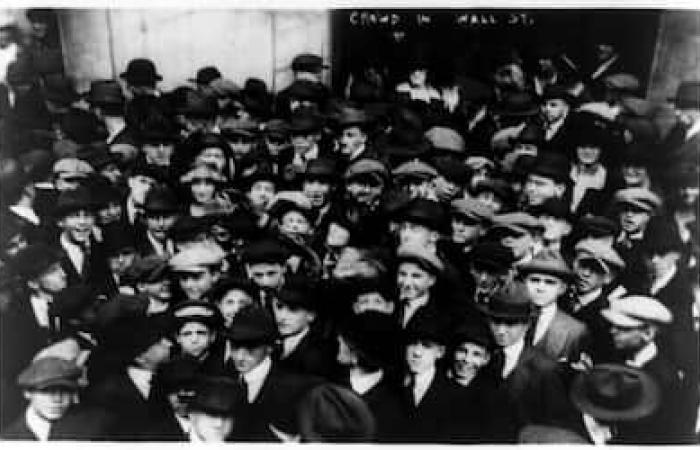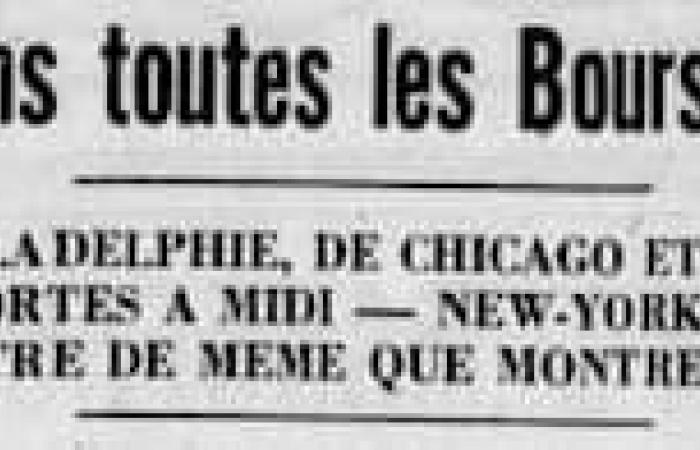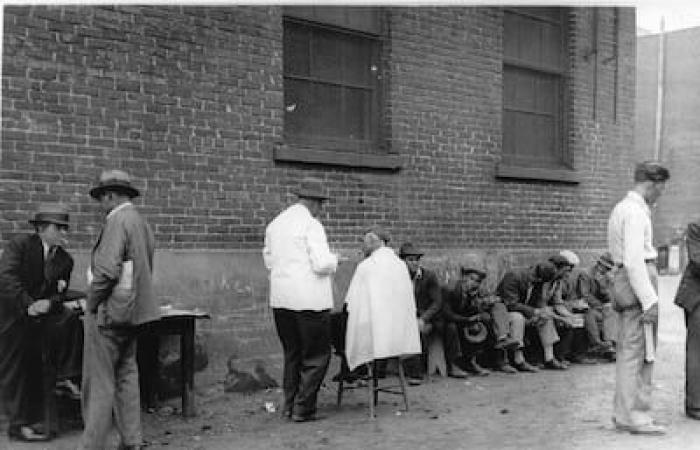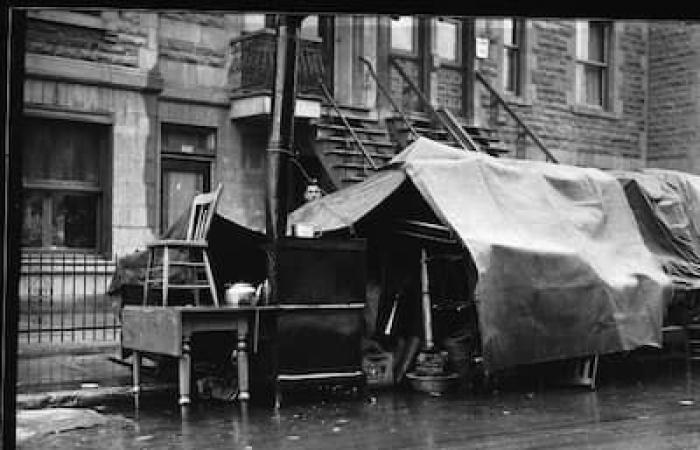On October 24, 1929, the value of stocks on the Wall Street Stock Exchange suddenly collapsed. It was the start of an economic crisis that would last 10 years. Quickly, the shock wave caused by this crash was felt in Quebec and throughout the world.
After the deprivations linked to the First World War and the suffering caused by the Spanish flu, the economic, political, social and cultural situation became more favorable in America. North Americans are filled with a passion for life. The war economy gave way to domestic production, factories produced more than ever and consumed a lot and often on credit. Moreover, on the stock market, the majority of transactions are made with borrowed money. This new capital will inevitably tend to create bidding wars and a surge in share prices. It must be said that from 1926, Wall Street allowed the purchase of shares on credit with capital of only 10%. Imagine… with $1 in their pocket, Americans could buy $10 worth of shares. Obviously, these securities obtained on credit will amplify speculation and be at the origin of the stock market crash.
The Stock Exchange is located in the southern borough of Manhattan.
Photo domaine public
Did you know that in the 17th century, a wall made of logs and earth protected the colony of New Amsterdam? The etymology of Wall Street comes from the creation of this wall. Another etymological source suggests that the name comes from the first buyer of Manhattan, the Walloon Pierre Minuit.
Photo Library of Congress
BLACK THURSDAY
On the floor of the New York Stock Exchange, up to 3 or 4 million shares are regularly traded per day. This proportion rose to 8 million in the spring of 1929. The speculative bubble was too intense, factories overproduced, warehouses were overflowing. The capitalist model based on excessive consumption risks collapsing like a house of cards in the fall of 1929 and the major newspapers talk about it daily. If everyone seems carefree, or rather happy with the opportunities offered by this stock market game, on the side of economists, the concern is palpable.
«Stock prices have reached what looks like a permanently high plateau.»
Irving Fisher, economist (October 16, 1929)
A first shock hit the markets on Wednesday October 23, 1929. That day, the volume of stock sales caused stock prices to plunge. The next morning, the Stock Exchange barely opens its doors when the market loses another 11% of its value. This October 24, which has become famous in history, will be called “Black Thursday”. Panic will seize the markets, then bankers, businessmen and possibly politicians. No less than 13 million shares are put up for sale. Fear spreads to the Toronto Stock Exchange and causes stocks to fall on the Montreal side, almost all prices end the day down. The New York Stock Exchange temporarily closed its doors to calm things down and on October 29, when it reopened, the liquidation of stocks intensified. It’s panic. In one trading session, losses are equivalent to 10 times the annual budget of the American government. The future British Prime Minister Winston Churchill, who was in New York in the days following the crash, would tell the Daily Telegraph having seen a discouraged businessman throw himself from the 15e floor and crashed in front of his hotel window. This stock market debacle will be the event which will mark the beginning of a gigantic depression which will affect America, Europe, then the entire world.

Photo domaine public

The crash of 1929.
Photo BAnQ, Le Devoir, October 24, 1929, p. 3, online
The worst thing is the predictability of this crash of 1929, the simple result of a weakening of growth which had been felt for months, but which investors seemed to ignore. The crash of October 1929 was in fact only one link in an economic chain that was falling apart. Stock market movements absolutely no longer corresponded to the state of the economic situation for weeks. In a short time, the shares lost 80% of their value. Obviously, the slowdown was going to lead to massive resales of securities. This crash only played the role of an accelerator of an looming crisis.
COLLAPSE OF THE ECONOMY
Many companies are going bankrupt or slowing down production. For example, JP Morgan Jr. lost between $20 and $60 million and the Rockefeller family saw its fortune fall by 80%. Unemployment is skyrocketing, citizens’ purchasing power is disrupted. In 1929, the Canadian automobile industry exported 102,000 vehicles; by 1931, that number dropped to just 13,000. In towns like Windsor, the unemployment rate rose to 50%. This crash quickly spread its shock wave to Montreal, grain exports passing through its port were slowed down, day laborers were sent home, the same observation in the Angus railway workshops in Rosemont. Construction is practically stopped, like a game of dominoes, the entire North American industrial and commercial cluster is heavily affected. Obviously, we still have to pay rent, electricity, groceries and all that in a society without a state social safety net. To survive, mothers do laundry, cultivate small gardens and find space to accommodate lodgers. The youngest crisscross the railway tracks to collect pieces of coal dropped by the convoys. Many, consumed by despair, leave the city to return to the family farm.

Unemployed people getting their hair cut in Montreal (circa 1935)
Photo McCord Museum

Family on the sidewalk in 1930.
Photo McCord Museum
In the United States, it was only in 1932 that the government gave some hope with its famous New Deal. In Canada, the reaction was a little slower; it was not until 1934 that the Bennett government formulated its Bank of Canada Act. This initiative, which led to the creation of the Bank of Canada in 1935, will not put bread on the table, but will be very useful in the coming years to regulate inflation, for example.
All these measures took a long time to structure. It was not until the first shots of the Second World War that the factories regained their strength and the North American economy emerged from this crisis.

